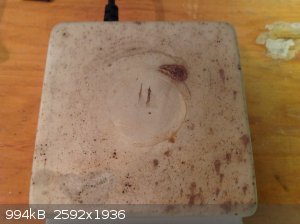RocksInHead
Harmless

Posts: 39
Registered: 16-6-2016
Member Is Offline
Mood: Highly Nitrated
|
|
Hotplate/Magnetic Stirrer care
Hi everyone, recently my hotplate/mag. stirrer has gotten quite dirty on the heating surface, and I have no idea how to clean it. I've tried various
solvents (acetone, 2-propanol, ethanol, etc.) and these "stains" just won't come off. I am now wondering if I can move to more harsh chemicals such as
acids and bases to remove the stains. They only seem to be carbon or various oxides from when something got on it and was decomposed.
I know it doesn't affect the effectiveness of the device, but it would just be nice if I could clean it up a bit. I am not sure if I should though
because the heating surface seems to be aluminium or iron, and that is why I am asking, because I don't want to ruin my 300$ hotplate just by trying
to clean it. Will acids take the stains off? But at what cost?
Thanks in advance!

|
|
|
Varmint
Hazard to Others
  
Posts: 264
Registered: 30-5-2013
Location: Near Atlanta, GA
Member Is Offline
Mood: No Mood
|
|
I have a Corning with the porcelain top, and I've had good luck with "vinegar steam" treatments, where I moisten a clean rag (cotton only no
plastics!) with vinegar, and hit the plate while it is 150C or so.
This wont get everything of course, but then I turn to Bar Keeper's Friend on a moist rag, and get after it with lots of elbow grease.
Anything remaining falls victim to my old time electric draftsmans eraser with the white insert normally use for ink on vellum work.
The only hint my Corning isn't brand new is a few spots on the gray paint where some boiling compound bleached the gray ever so slightly.
|
|
|
gdflp
Super Moderator
      
Posts: 1320
Registered: 14-2-2014
Location: NY, USA
Member Is Offline
Mood: Staring at code
|
|
Quote: Originally posted by Varmint  | I have a Corning with the porcelain top, and I've had good luck with "vinegar steam" treatments, where I moisten a clean rag (cotton only no
plastics!) with vinegar, and hit the plate while it is 150C or so.
This wont get everything of course, but then I turn to Bar Keeper's Friend on a moist rag, and get after it with lots of elbow grease.
Anything remaining falls victim to my old time electric draftsmans eraser with the white insert normally use for ink on vellum work.
The only hint my Corning isn't brand new is a few spots on the gray paint where some boiling compound bleached the gray ever so slightly.
|
I do that all the time with distilled water and it works great, never thought to try it with vinegar. I'll have to give it a shot, thanks for the
idea. I do distinctly remember 50% acetic acid working well at RT when I spilled ink on my hot plate (long story).
|
|
|
Deathunter88
National Hazard
   
Posts: 508
Registered: 20-2-2015
Location: Beijing, China
Member Is Offline
Mood: No Mood
|
|
The best way I have found: Heat the hotplate to 200-ish degrees ˚C. Use a pipet to drip 30% hydrogen peroxide over the surface. The boiling peroxide
instantly removes any and all carbon/other deposits. The hotplate surface is left like new. I was amazed when I spilled some 30% hydrogen peroxide
onto my almost black hotplate and have it transformed into a condition like new.
|
|
|
RocksInHead
Harmless

Posts: 39
Registered: 16-6-2016
Member Is Offline
Mood: Highly Nitrated
|
|
Quote: Originally posted by Deathunter88  | | The best way I have found: Heat the hotplate to 200-ish degrees ˚C. Use a pipet to drip 30% hydrogen peroxide over the surface. The boiling peroxide
instantly removes any and all carbon/other deposits. The hotplate surface is left like new. I was amazed when I spilled some 30% hydrogen peroxide
onto my almost black hotplate and have it transformed into a condition like new. |
Thanks! I tried it, and the other methods, but this one worked out best.
|
|
|